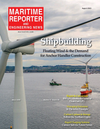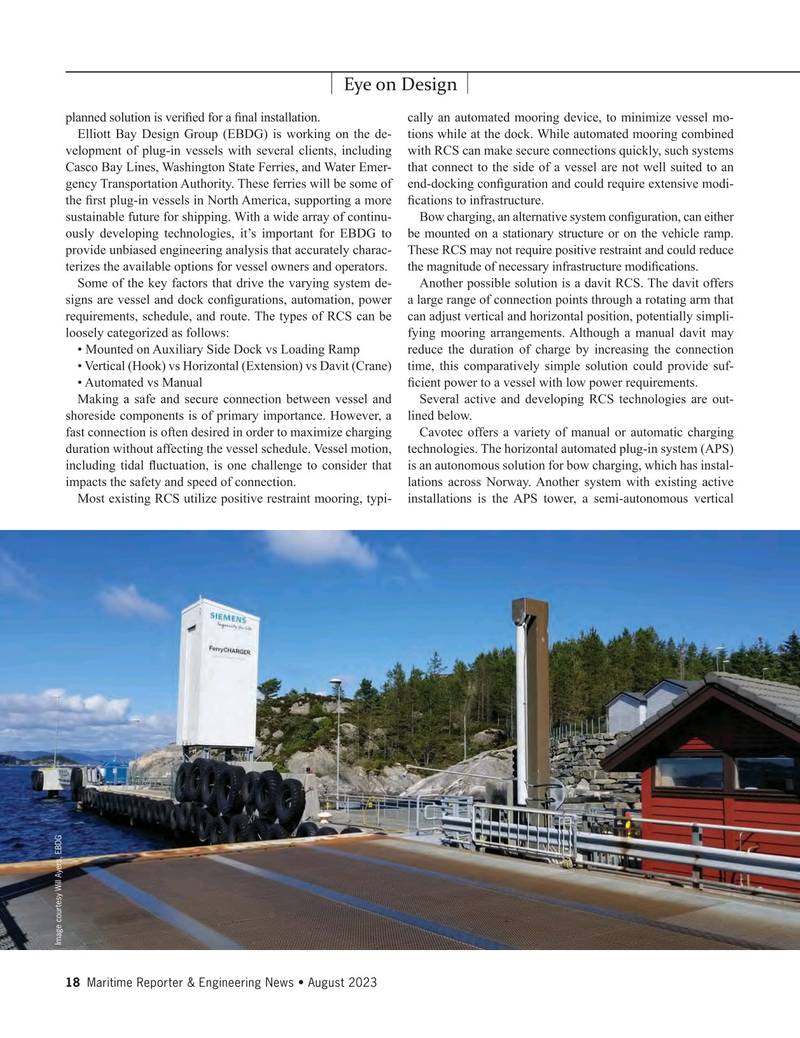
Page 18: of Maritime Reporter Magazine (August 2023)
Shipyard Annual
Read this page in Pdf, Flash or Html5 edition of August 2023 Maritime Reporter Magazine
Eye on Design planned solution is veri? ed for a ? nal installation. cally an automated mooring device, to minimize vessel mo-
Elliott Bay Design Group (EBDG) is working on the de- tions while at the dock. While automated mooring combined velopment of plug-in vessels with several clients, including with RCS can make secure connections quickly, such systems
Casco Bay Lines, Washington State Ferries, and Water Emer- that connect to the side of a vessel are not well suited to an gency Transportation Authority. These ferries will be some of end-docking con? guration and could require extensive modi- the ? rst plug-in vessels in North America, supporting a more ? cations to infrastructure.
sustainable future for shipping. With a wide array of continu- Bow charging, an alternative system con? guration, can either ously developing technologies, it’s important for EBDG to be mounted on a stationary structure or on the vehicle ramp. provide unbiased engineering analysis that accurately charac- These RCS may not require positive restraint and could reduce terizes the available options for vessel owners and operators. the magnitude of necessary infrastructure modi? cations.
Some of the key factors that drive the varying system de- Another possible solution is a davit RCS. The davit offers signs are vessel and dock con? gurations, automation, power a large range of connection points through a rotating arm that requirements, schedule, and route. The types of RCS can be can adjust vertical and horizontal position, potentially simpli- loosely categorized as follows: fying mooring arrangements. Although a manual davit may • Mounted on Auxiliary Side Dock vs Loading Ramp reduce the duration of charge by increasing the connection • Vertical (Hook) vs Horizontal (Extension) vs Davit (Crane) time, this comparatively simple solution could provide suf- • Automated vs Manual ? cient power to a vessel with low power requirements.
Making a safe and secure connection between vessel and Several active and developing RCS technologies are out- shoreside components is of primary importance. However, a lined below.
fast connection is often desired in order to maximize charging Cavotec offers a variety of manual or automatic charging duration without affecting the vessel schedule. Vessel motion, technologies. The horizontal automated plug-in system (APS) including tidal ? uctuation, is one challenge to consider that is an autonomous solution for bow charging, which has instal- impacts the safety and speed of connection. lations across Norway. Another system with existing active
Most existing RCS utilize positive restraint mooring, typi- installations is the APS tower, a semi-autonomous vertical
Image courtesy Will Ayers, EBDG 18 Maritime Reporter & Engineering News • August 2023
MR #8 (18-33).indd 18 8/3/2023 10:49:57 AM

 17
17

 19
19
